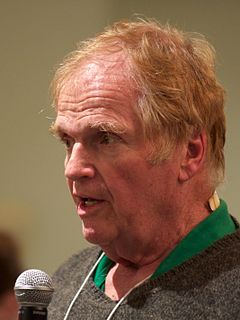Related Research Articles

In language, a clause is a part of the sentence that contains a verb. A typical clause consists of a subject and a predicate, the latter typically a verb phrase, a verb with any objects and other modifiers. However, the subject is sometimes not said or explicit, often the case in null-subject languages if the subject is retrievable from context, but it sometimes also occurs in other languages such as English.
In linguistics, code-switching or language alternation occurs when a speaker alternates between two or more languages, or language varieties, in the context of a single conversation. Multilinguals, speakers of more than one language, sometimes use elements of multiple languages when conversing with each other. Thus, code-switching is the use of more than one linguistic variety in a manner consistent with the syntax and phonology of each variety.
In syntax, verb-second (V2) word order places the finite verb of a clause or sentence in second position with a single constituent preceding it, which functions as the clause topic.
Dependency grammar (DG) is a class of modern grammatical theories that are all based on the dependency relation and that can be traced back primarily to the work of Lucien Tesnière. Dependency is the notion that linguistic units, e.g. words, are connected to each other by directed links. The (finite) verb is taken to be the structural center of clause structure. All other syntactic units (words) are either directly or indirectly connected to the verb in terms of the directed links, which are called dependencies. DGs are distinct from phrase structure grammars, since DGs lack phrasal nodes, although they acknowledge phrases. Structure is determined by the relation between a word and its dependents. Dependency structures are flatter than phrase structures in part because they lack a finite verb phrase constituent, and they are thus well suited for the analysis of languages with free word order, such as Czech or Warlpiri.
A verbum dicendi, also called verb of utterance, is a word that expresses speech or introduces a quotation. English examples of verbs of speaking include say, utter, ask and rumble. Because a verbum dicendi often introduces a quotation, it may grammaticalize into a quotative.
In linguistics, binding is the distribution of anaphoric elements. A pronoun usually has an antecedent in context. The goal of binding theory is to identify the syntactic relationship that can or must hold between a given pronoun or noun and its antecedent, e.g. Johni said hei would help vs. *Hei said Johni would help.
In linguistics, wh-movement concerns rules of syntax involving the placement of interrogative words. In plain terms, it refers to an asymmetry between the syntactical arrangement of words or morphemes in a question and the form of answers to that question; specifically, the placement of the question word. An example in English is "What are you doing?", a response to which could be "I am editing Wikipedia."; in which the answer is at the end of the sentence but the question word (What) is at the beginning.

John Robert "Haj" Ross is a poet and linguist. He played a part in the development of generative semantics along with George Lakoff, James D. McCawley, and Paul Postal. He was a professor of linguistics at MIT from 1966–1985 and has worked in Brazil, Singapore and British Columbia. He is currently at the University of North Texas.
In linguistics, raising constructions involve the movement of an argument from an embedded or subordinate clause to a matrix or main clause; in other words, a raising predicate/verb appears with a syntactic argument that is not its semantic argument, but is rather the semantic argument of an embedded predicate. Although English has raising constructions, not all languages do.
In syntax, sluicing is a type of ellipsis that occurs in both direct and indirect interrogative clauses. The ellipsis is introduced by a wh-expression, whereby in most cases, everything except the wh-expression is elided from the clause. Sluicing has been studied in detail in early 21st century and it is therefore a relatively well understood type of ellipsis. Sluicing occurs in many languages.
In linguistics, ellipsis or an elliptical construction is the omission from a clause of one or more words that are nevertheless understood in the context of the remaining elements. There are numerous distinct types of ellipsis acknowledged in theoretical syntax. This article provides an overview of them. Theoretical accounts of ellipsis can vary greatly depending in part upon whether a constituency-based or a dependency-based theory of syntactic structure is pursued.
In linguistics, a small clause consists of a subject and its predicate, but lacks an overt expression of tense. Small clauses have the semantic subject-predicate characteristics of a clause, and have some, but not all, the properties of a constituent. Structural analyses of small clauses vary according to whether a flat or layered analysis is pursued. The small clause is related to the phenomena of raising-to-object, exceptional case-marking, accusativus cum infinitivo, and object control.
In linguistics, coordination is a complex syntactic structure that links together two or more elements; these elements are called conjuncts or conjoins. The presence of coordination is often signaled by the appearance of a coordinator, e.g. and, or, but. The totality of coordinator(s) and conjuncts forming an instance of coordination is called a coordinate structure. The unique properties of coordinate structures have motivated theoretical syntax to draw a broad distinction between coordination and subordination. It is also one of the many constituency tests in Linguistics. Coordination is one of the most studied fields in theoretical syntax, but despite decades of intensive examination, theoretical accounts differ significantly and there is no consensus on the best analysis.
Exceptional case-marking (ECM), in linguistics, is a phenomenon in which the subject of an embedded infinitival verb seems to appear in a superordinate clause and, if it is a pronoun, is unexpectedly marked with object case morphology. The unexpected object case morphology is deemed "exceptional". The term ECM itself was coined in the Government and Binding grammar framework although the phenomenon is closely related to the accusativus cum infinitivo constructions of Latin. ECM-constructions are also studied within the context of raising. The verbs that license ECM are known as raising-to-object verbs. Many languages lack ECM-predicates, and even in English, the number of ECM-verbs is small. The structural analysis of ECM-constructions varies in part according to whether one pursues a relatively flat structure or a more layered one.
In linguistics, locality refers to the proximity of elements in a linguistic structure. Constraints on locality limit the span over which rules can apply to a particular structure. Theories of transformational grammar use syntactic locality constraints to explain restrictions on argument selection, syntactic binding, and syntactic movement.
In linguistics, gapping is a type of ellipsis that occurs in the non-initial conjuncts of coordinate structures. Gapping usually elides minimally a finite verb and further any non-finite verbs that are present. This material is "gapped" from the non-initial conjuncts of a coordinate structure. Gapping exists in many languages, but by no means in all of them, and gapping has been studied extensively and is therefore one of the more understood ellipsis mechanisms. Stripping is viewed as a particular manifestation of the gapping mechanism where just one remnant appears in the gapped/stripped conjunct.
Logophoricity is a phenomenon of binding relation that may employ a morphologically different set of anaphoric forms, in the context where the referent is an entity whose speech, thoughts, or feelings are being reported. This entity may or may not be distant from the discourse, but the referent must reside in a clause external to the one in which the logophor resides. The specially-formed anaphors that are morphologically distinct from the typical pronouns of a language are known as logophoric pronouns, originally coined by the linguist Claude Hagège. The linguistic importance of logophoricity is its capability to do away with ambiguity as to who is being referred to. A crucial element of logophoricity is the logophoric context, defined as the environment where use of logophoric pronouns is possible. Several syntactic and semantic accounts have been suggested. While some languages may not be purely logophoric, logophoric context may still be found in those languages; in those cases, it is common to find that in the place where logophoric pronouns would typically occur, non-clause-bounded reflexive pronouns appear instead.
In linguistics, a discontinuity occurs when a given word or phrase is separated from another word or phrase that it modifies in such a manner that a direct connection cannot be established between the two without incurring crossing lines in the tree structure. The terminology that is employed to denote discontinuities varies depending on the theory of syntax at hand. The terms discontinuous constituent, displacement, long distance dependency, unbounded dependency, and projectivity violation are largely synonymous with the term discontinuity. There are various types of discontinuities, the most prominent and widely studied of these being topicalization, wh-fronting, scrambling, and extraposition.
Extraposition is a mechanism of syntax that alters word order in such a manner that a relatively "heavy" constituent appears to the right of its canonical position. Extraposing a constituent results in a discontinuity and in this regard, it is unlike shifting, which does not generate a discontinuity. The extraposed constituent is separated from its governor by one or more words that dominate its governor. Two types of extraposition are acknowledged in theoretical syntax: standard cases where extraposition is optional and it-extraposition where extraposition is obligatory. Extraposition is motivated in part by a desire to reduce center embedding by increasing right-branching and thus easing processing, center-embedded structures being more difficult to process. Extraposition occurs frequently in English and related languages.
In linguistics, the term right node raising (RNR) denotes a sharing mechanism that sees the material to the immediate right of parallel structures being in some sense "shared" by those parallel structures, e.g. [Sam likes] but [Fred dislikes] the debates. The parallel structures of RNR are typically the conjuncts of a coordinate structure, although the phenomenon is not limited to coordination, since it can also appear with parallel structures that do not involve coordination. The term right node raising itself is due to Postal (1974). Postal assumed that the parallel structures are complete clauses below the surface. The shared constituent was then raised rightward out of each conjunct of the coordinate structure and attached as a single constituent to the structure above the level of the conjuncts, hence "right node raising" was occurring in a literal sense. While the term right node raising survives, the actual analysis that Postal proposed is not widely accepted. RNR occurs in many languages, including English and related languages.
References
- de Haan, German (2001). "More is going on upstairs than downstairs: Embedded root phenomena in West Frisian". The Journal of Comparative Germanic Linguistics . 4 (1): 3–38. doi:10.1023/A:1012224020604.
- Merchant, Jason (2007). Three kinds of ellipsis (PDF) (Ms. thesis). University of Chicago. Archived from the original (PDF) on August 30, 2008.
- Ross, John R. (1973). "The penthouse principle and the order of constituents". In Corum, C. T.; Smith-Stark, T. C.; Weiser, A. (eds.). You Take the High Node and I’ll Take the Low Node. Chicago: Chicago Linguistic Society. pp. 397–422. OCLC 705105.